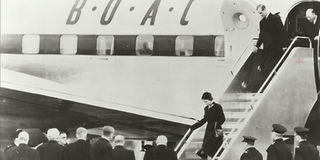Queen Elizabeth marks 60 years on the throne

Photo/FILE
The new Queen Elizabeth arrives in London from Nairobi on February 7, 1952. She was flown home on a British Overseas Airline Company flight, predecessor of British Airways.
When Princess Elizabeth left London in February 1952 for an official tour of Kenya, New Zealand and Australia, she never knew that fate was about to put her on the throne of the world superpower of the day without warning.
Princess Elizabeth had married Philip Mountbatten in 1947. One of the wedding gifts from her father, King George VI, was the colonial-era Sagana State Lodge located on the edge of Mt Kenya.
Today, that gift is one of the seven State lodges appended to State House for presidential travel.
It must have been an exciting moment for the young princess and her husband to finally see their wedding gift.
Her travel to Kenya and on to Asia and Australia had initially been planned for her father, but since he was ailing, he decided to send the heir apparent in his place. (READ: Queen’s getaway in search of lost glory)
Official publications in Britain quote her private secretary Martin Charteris saying the Queen had been photographing animals from the Treetops Hotel – built at a watering hole that still provides spectacular game viewing – and “looking wonderful in blue jeans”.
That was 60 years ago, and the history of the world would change in an instant.
The British Empire, then a superpower whose influence spread as far as Canada and Australia and with colonies and territories across Africa and beyond, was in the throes of a historic moment.
Suddenly, when she was just 27, duty called, and the princess had to rush back to England.
In a dramatic twist of fate, the accession would take place, quite literally, on a tree top and not at the grounds of Buckingham Palace, the official seat of the British monarchy, or at Windsor Castle, the magnificent 900-year-old fortress that is one of the most important bastions of the British monarchy.
Princess Elizabeth and her husband Prince Philip were staying in a lodge built in a tree from where they were watching wildlife and spending the night when King George died in his sleep.
It had been a dramatic visit. The British media, cuttings kept by the Aberdare Safari Hotel which runs the Treetops Hotel today show, were awash with excitement that Princess Elizabeth was going to watch wild animals and spend a night in a treetop and with elephants, buffaloes and rhinos not afar off.
They savoured details about the dangers of going into the wild and even what she would wear.
Because she wore brown trousers, it was reported, she would not appear in public on her journey from the Sigona Golf Club, then known as the Sigona Royal Club, to the Treetops.
The legendary Indian hunter and conservationist Jim Corbett, a resident of Treetops at the time, wrote the now famous lines in the visitors’ log book:
“For the first time in the history of the world, a young girl climbed into a tree one day a Princess and after having what she described as her most thrilling experience she climbed down from the tree next day a Queen — God bless her.”
The first Treetops Hotel structure – it would be burnt down by the Mau Mau freedom fighters in 1954 – was built by Eric Sherbrooke Walker, a major in the British army at the time.
It was a fascinating concept where a mugumo--an African fig tree--formed the foundation of the three-room hotel.
The Treetops Hotel in the Aberdare forest has been a twin of the Outspan Hotel in Nyeri town since Mr Walker built it. It changed hands in 1978.
The preparations for a member of royalty of a superpower visiting the Treetops and spending a night in the forest had been more than elaborate. One man, Nahashon Muriithi, who worked as a porter at the hotel, witnessed it.
Little known and living a peasant life in Kamuyu village, Nyeri, Mr Muriithi told the Sunday Nation this week: “I still remember that evening very well.
“The news came at about 10pm. Everything about the excited mood suddenly changed. The whole place was covered in gloom.”
That night Mr Muriithi was helping a cook named Nderitu prepare meals for the princess and her party. It was a big deal because the colour bar was stiffly in place.
“We had been preparing for two weeks. There was a cooking competition, and the hotel owner’s wife and daughter competed with us (African workers) in preparing firewood-cooked meals.
“Eventually, I was among those who performed the tasks well, and I was picked to be in the princess’ party,” Mr Muriithi said.
“Obviously, we had not been told who the visitor would be. We were only directed to prepare elaborately, far more than we would on ordinary days, and would only come to know who we were hosting on the actual day.”
This week, he walked the Sunday Nation team along the trail the party took six decades ago to the spot where the first lodge was and where buffaloes and elephants still roam.
“The British citizens ran their own show. I do not recall of any other nationality allowed near the Princess. They were all very excited about the visit.
“They even posted armed sentries who spent the night in treetops to ward off any danger, and these were also Englishmen. It was elaborate.
“It was much more elaborate than that of any other visitor before that,” said Mr Muriithi, now 84.
As fate would have it, the news of her father’s death cut short her trip, and she had to return to London to mourn and prepare for her coronation.
But in Kenya, the agitation for independence was growing, and the Mau Mau fighters were raising their stakes.
Mr Muriithi still recalls the day the Mau Mau struck the Treetops. He was then serving as a lookout for the British men fighting the Mau Mau.
The raiders’ intention was to abduct the African men who worked at the lodge and forcibly conscript them into the Mau Mau.
“I escaped with a bullet wound,” Mr Muriithi said, pointing to a three-inch scar he has carried since. “I do not know what happened to my colleagues; I have never seen them since.”
A lucky escapee, he crawled through bush and then self-treated his wound using herbs.
“I did not want to seek conventional treatment in hospital because that would expose me. I had to hide. Thankfully, my father had taught me about medicinal herbs. I used those until I recovered,” he said.
He then began looking for menial jobs. Sixty years and eight children later, Mr Muriithi, one of the men who helped carry the luggage of a princess in one day and a queen the next, says he does not even own a piece of land as he would have wished.
And, of the British monarch and her government, he said: “I would like the Queen and her government, as they celebrate 60 years, to know that I wish them well but that I have lived a poor man all these years.”
Rich and famous
Following the media hype over the ascension of Elizabeth II, the Treetops attracted a large number of rich and famous people every year.
Some famous personalities included the late Princess Diana and her husband Charles in 1992. Their picture from the visit still hangs on the walls.
Another spectacular picture is that of former President Moi, then a younger man, with his wife Lena. It has also been a subject of numerous newspaper articles and other writings.
The Treetops has numerous fond mentions in Britain, and it was recalled again this week at the celebrations at Windsor Castle.
In 1983, Queen Elizabeth returned to Kenya for a five-day visit during which she also visited the Treetops.
The Queen and her husband travelled around the country in a special carriage dating back to colonial days, the last time it was used.
This week, a curtain raiser pageant has been held at Windsor Castle featuring troupes, dancers and horse riders from around the world, touching on special interests to the Queen. There were more than 500 horses and 800 performers.
Moses Ndung’u, a Kenyan dancer, told AFP on the sidelines of the celebrations: “It is a big honour for us.
“The queen became a queen in our country. Our grandparents cooked for her. We have an attachment to her – we feel proud to be part of that history.”
The Nairobi Chamber Chorus is also participating in the celebrations.




